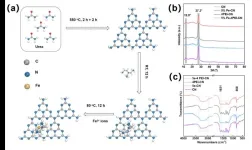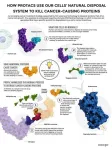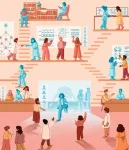(Press-News.org) Cultivating creativity in schools is vital for a future driven by artificial intelligence (AI). But while teachers embrace creativity as an essential 21st century skill, a lack of valid and reliable creativity tests means schools struggle to assess student achievement.
Now, a new machine-learning model developed by the University of South Australia is providing teachers with access to high-quality, fit-for-purpose creativity tests, that can score assessments in a fraction of the time and a fraction of the cost.
Applied to the current empirical creativity test – Test of Creative Thinking – Drawing Production (TCT-DP) – the new algorithm marks a test in a single millisecond, as opposed to the standard 15-minute human-marked test.
The development could save teachers thousands of hours in an already overloaded schedule.
Lead researcher, UniSA’s Prof David Cropley says the algorithm presents a game changing innovation for schools.
“Creativity is an essential skill for the next generation, particularly because it is a skill that cannot be automated,” Prof Cropley says.
“But because there is a lack of affordable and efficient tools to measure creativity in schools, students are either not being tested, or are being graded subjectively, which is inconsistent and unreliable.
“The TCT-DP test has long been acknowledged as the premier tool to assess creativity in school aged children, but as it is expensive, slow, and labour-intensive, it’s out of reach for most schools.
“Our algorithm changes this. Not only is the cost of running the algorithm reduced by a factor of more than 20, but the results are fast and incredibly accurate.
“For example, a manually scored test for a school with 1000 students would cost approximately $25,000 and require about 10-weeks to receive test results; with UniSA’s algorithm, the same testing could be conducted for approximately $1000 with results delivered in 1-2 days.
“This puts the test within direct reach of schools and teachers, giving them the means to assess creativity accurately and cheaply.”
Co-researcher, UniSA’s Dr Rebecca Marrone says the capacity to test and measure creativity has additional benefits for students who are sometimes overlooked.
“Testing for creativity opens up an avenue beyond more traditional intelligence testing,” Dr Marrone says.
“Testing for creativity helps identify students who may have abilities that do not show up on traditional approaches to testing in school. For example, a child who does poorly on traditional IQ tests, but is highly creative, could easily slip through the cracks.
“Developing creativity also protects children on the lower end of the achievement spectrum by training them in a skill that is not vulnerable to automation, which can help buffer them against the effects of digital transformation.”
The algorithm is currently being developed as a desktop app for teachers to use in the classroom. Ahead of this, classroom teachers interested in using the TCT-DP are invited to contact the UniSA team to discuss their needs.
Notes to editors:
The full article can be accessed her: Cropley, D. H., Theurer, C., Mathijssen, A. C. S., & Marrone, R. L. (2024). Fit-For-Purpose Creativity Assessment: Automatic Scoring of the Test of Creative Thinking – Drawing Production (TCT-DP). Creativity Research Journal, 1–16.
………………………………………………………………………………………………………………………….
Media contact: Annabel Mansfield E: Annabel.Mansfield@unisa.edu.au M: +61 479 182 489
Researchers contacts: Prof David Cropley E: David.Cropley@unisa.edu.au
Dr Rebecca Marrone E: Rebecca.Marrone@unisa.edu.au
END
The AI paradox: Building creativity to protect against AI
2024-05-30
ELSE PRESS RELEASES FROM THIS DATE:
Visible light-induced photocatalysis–self-Fenton degradation of P-Clphoh over graphitic carbon nitride by a polyethylenimine bifunctional catalyst
2024-05-30
The deep degradation of organic pollutants through solar light-coupled photocatalysis and the Fenton reaction (Photo-Fenton) holds significant importance in the field of water purification. In this study, a novel bifunctional catalyst (Fe-PEI-CN) was synthesized by electrostatic self-assembly and hydrothermal methods, doping graphene-like carbon nitride (CN) with polyethyleneimine (PEI) and iron (Fe) species. This catalyst efficiently degraded p-chlorophenol (p-ClPhOH) by generating hydrogen peroxide (H2O2) during the photocatalytic process. The relationship between catalytic efficiency and structure was explored using various characterization techniques.Under ...
Engineered DNA 'warhead' targets a common cancer mutation
2024-05-30
Tumour protein P53 (TP53) plays an important role in suppressing the growth of tumours. Mutations in the gene for TP53 can have a disastrous effect, hampering the body's ability to fight tumours and even encouraging their growth. Because these are the most common mutations in cancers, TP53 has long been an interesting therapeutic target. However, efforts to destroy the mutant protein have been hampered by the difficulty of finding a way to bind to it.
Now, a team of researchers from Xi'an ...
Picture this: Snapping photos of our food could be good for us
2024-05-30
New Curtin University research reveals taking pictures of food isn’t just content for our social media feeds, but could be the key to improving people’s diets.
Published in the prestigious American Journal of Clinical Nutrition, the feeding study saw researchers measure the weight of meals, which were then provided to participants over a day for breakfast, lunch and dinner.
Participants compared different technology-assisted methods to recall what they had eaten over the past 24 hours.
One method asked participants to take photos of their meals using the mobile Food Record app.
These ...
Portable pathology passes the test
2024-05-30
On-site pathology tests for infectious diseases in rural and remote locations can be just as reliable and accurate as tests carried out in a hospital laboratory, a new report from Flinders University shows.
Flinders University researchers tested the quality of on-site pathology testing, or Point-of-Care-Testing (POCT), for molecular-based, severe acute respiratory syndrome coronavirus 2 (SARS-CoV-2) detection in over 100 remote Aboriginal and Torres Strait Islander communities across Australia.
“Our study demonstrates that when point-of-care testing models are effectively established and managed, the quality of pathology results can be equivalent to ...
USC medical school dean appointed to CIRM board
2024-05-30
Carolyn C. Meltzer, MD, dean of the Keck School of Medicine of USC, has been appointed to the board overseeing the California Institute of Regenerative Medicine (CIRM). CIRM is the voter-created agency that funds stem cell research throughout the state.
“Stem cell research holds the tremendous promise to unlock health solutions that patients need,” said Steven D. Shapiro, MD, USC’s senior vice president for health affairs. “The CIRM board—and the people of our state—will benefit greatly from Meltzer’s wide-ranging leadership experience and place at the ...
Antibiotic pollution disrupts the gut microbiome and blocks memory in aquatic snails
2024-05-30
Antibiotics prevent snails from forming new memories by disrupting their gut microbiome - the community of beneficial bacteria found in their guts.
The new research, led by the University of East Anglia (UEA) in collaboration with Aberystwyth University, highlights the damaging effects that human pollution could be having on aquatic wildlife.
In the study, pond snails were given a favourite food – carrot juice – but had to quickly learn and remember that it was no longer safe to eat.
Snails ...
Researchers expose new symbiosis origin theories, identify experimental systems for plant life
2024-05-30
STARKVILLE, Miss.— A Mississippi State faculty member’s work on symbiosis—a mutually beneficial relationship between living organisms—is pushing back against the newer theory of a “single-origin” of root nodule symbiosis (RNS)—that all symbiosis between plant root nodules and nitrogen-fixing bacteria stems from one point—instead suggesting a “multiple-origin” theory of symbiosis which opens a better understanding for genetically engineering crops.
Ryan A. Folk, an assistant professor in the MSU Department of Biological Sciences and herbarium curator, is an author on a paper published this month in Nature ...
Q&A: How AI affects kids’ creativity
2024-05-30
Shortly after artificial intelligence models including Midjourney and OpenAI’s Dall-E went public, AI-generated art started winning competitions: one in digital art, another in photography. Concern rumbled that AI could replace artists — and even, by some metrics, be more creative than humans. But simultaneously, people were exploring these tools as ways to augment their creative processes, not replace them.
University of Washington researchers grew curious about how AI might affect creativity in children, specifically, so they worked with a group of 12 Seattle-area kids ages seven to 13 to explore how the kids’ creative processes interacted ...
Virtual lab meetings improve undergraduate research experience and foster diversity in academia
2024-05-30
Moisés A. Bernal, assistant professor in the Department of Biological Sciences at Auburn University, is collaborating with researchers Kathleen Lotterhos (Northeast University), Megan Phifer-Rixey (Drexel University), and Torrance Hanley, (Sacred Heart University) to evaluate the effectiveness of virtual lab meetings in demystifying the hidden curriculum in academia, incentivize primary research among students without previous experience, and foster participation of underrepresented groups in STEM.
The “Biological Practices” article entitled A virtual lab meeting training program mutually benefits mentees and host labs was recently published ...
Study shows effectiveness of updated COVID-19 vaccines wanes moderately over time, is lower against currently circulating variants
2024-05-30
May 29, 2024
Boosters that target the omicron subvariants of SARS-CoV-2 are still providing reasonably durable protection against infection, hospitalization and death from COVID-19, according to new data from a study led by researchers at the UNC Gillings School of Global Public Health.
Published today in the New England Journal of Medicine, the study found that COVID-19 boosters targeting the XBB.1.5 subvariants were most effective one month after receiving one. After four weeks, the vaccines were 52.2% effective at preventing infection and 66.8% effective at preventing hospitalization.
The vaccines were also highly effective ...





